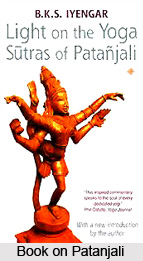 The fortieth yoga sutra describes about the principle of udana vayu - through the mastery of which one gains a supreme power to levitate, walk on water, or thorns, without being affected by those. By focussing on the udana vayu only, a yogi achieves the power to become totally light-bodied and can also make prana (breath) rise through brahmarandhra and thus die at his own will. However, ancient sages had the ultimate knowledge of the five basic functions of the vital energy force, (prana vayus) - prana, apana, samana, udana and vyana.
The fortieth yoga sutra describes about the principle of udana vayu - through the mastery of which one gains a supreme power to levitate, walk on water, or thorns, without being affected by those. By focussing on the udana vayu only, a yogi achieves the power to become totally light-bodied and can also make prana (breath) rise through brahmarandhra and thus die at his own will. However, ancient sages had the ultimate knowledge of the five basic functions of the vital energy force, (prana vayus) - prana, apana, samana, udana and vyana.
udana one of the five pranas or vital airs
jayat by conquest, mastery
jala water
pahka mud
kantaka thorns
adisu and so forth, and the rest
asangah non-contact
utkrantih ascension, levitation, going up and beyond
ca and
By mastery of udana vayu, the yogi can walk over water, swamps and thorns without touching them. He also has the power of levitation.
By samyama on udana vayu, the yogi can make his body so light that he is able to walk over water, mud and thorns without coming in contact with them. He can make prana ascend through brahmarandhra and thus die at will.
It is explained in III.37 that the yogi has the power of knowing the tanmatras - sound, touch, sight, taste and smell, which are the counterparts of the elements, whereas in 40-43, Patanjali speaks of the conquest of the elements - water, fire, air and ether.
Prana is usually translated as `breath`, yet this is only one of its manifestations in the human body. If breathing stops, so does life. Ancient Indian sages knew that all functions of the body were performed by five types of vital energy (prana vayus) - prana, apana, samana, udana and vyana. They are specific aspects of the one vital cosmic force, the primordial principle of existence in every being. The functions of the five prana vayus were described in III.32.
In pranayama, prana vayu is activated by the inbreath and apana vayu by the outbreath. Vyana is essential for the working of prana and apana, due to it being the medium for transferring energies from one to the other. Udana raises energy from the lower spine to the brain.
This sutra explains the powers gained by the yogi who masters udana vayu - he raises the energy, and is then able to walk over water. (Light on Yoga and Light on Pranayama.)
The following are some stories illustrating the powers gained by various yogis --
During the 8th century, a saint by the name of Tirumangai Alwar was on a pilgrimage, visiting various famous temples in South India. Accompanying him were four disciples, each of whom was gifted with a miraculous power. One was able to fascinate with his power of speech. His name was Tolarvalla Van. The second, Taludhavan, could open any lock by the power of his breath. The third, Nilalai Pidippan, could stop people from moving by tapping on their shadows, while the fourth, Nirmel Nadappan by name, could walk over water.
Tirumangai Alwar and his disciples arrived at the most holy shrine of Sri Rariganatha at Srirarigam on the bank of river Kaveri. It was in a lamentable condition and the saint wanted to reconstruct it. He asked a number of wealthy people for financial assistance, but no one responded to his appeal. He therefore made up his mind to become a leader of a band of robbers and asked his four pupils to use their powers to raise money for the temple. They obeyed the orders of their guru and collected money, materials and men for construction. It took years to complete the temple, which is known as the seven walls of Srirarigam temple near Tiruchirapalli (Trichy). When it was finished, he gave up robbery, but the workers started badgering him for money. As he did not respond to their demands, they wanted to murder him. He asked them to go to the opposite bank of the river, where he had hidden some money, and to distribute it equally among themselves. Then he whispered to his pupil who could walk over water that he should take them in a boat and sink the boat in the middle of the river. Due to heavy rains, the river was in spate. The disciple obeyed the orders of his guru, took them all aboard the boat, sank it and rejoined his guru.
Sadanandacharya, a pupil of Sri Shankaracharya, had walked over water at the call of his guru, who was on the other side of the river Gariga in Varanasi. People saw the imprints of his feet bearing a lotus flower; hence Sadanandacharya was known as Padmapadacharya (padma = lotus; pada = foot).
It is alleged that Brahmendra Svami, guru of Baji Rao I of Maharashtra, used to sit on a palm leaf and traverse the sea. It is also related to Jesus Christ, who is known to have walked over a lake to meet his disciples, awaiting him on the other side.




















